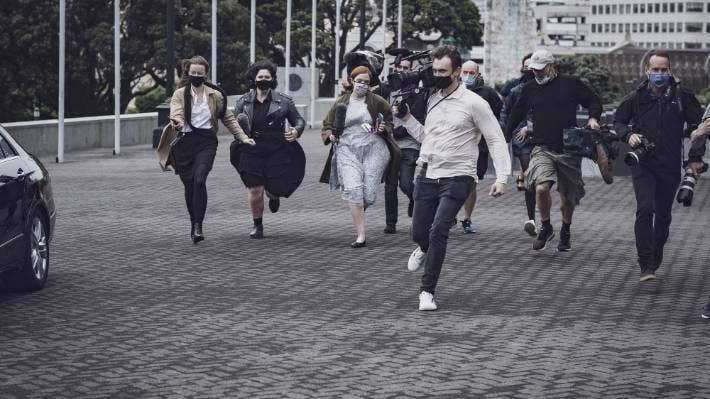One of the few bright spots in the pandemic was the entertainment of watching the stunned incomprehension of legacy media reporters coming face to face with people they’d relentlessly demonised and getting a serve back. It was like watching a yappy chihuahua finally getting a well-deserved rolled-up newspaper across its nose. Or the blank shock of Nicolae Ceausescu as he was booed by thousands of Romanians.
While the worst actual ‘violence’ meted out to a reporter was someone in Melbourne chucking a plastic water bottle at a TV reporter, you’d have thought the protesters were running wholesale lynching parties.
In the Spinoff interview, Anna Fifield and her interviewer discuss the difficulties in covering the protest, due to the levels of hostility directed at news reporters. Reporters were sent in pairs for ‘safety’.
Yet, that wasn’t the experience of BFD editor Cam Slater, when he visited and addressed the protest in Wellington. Nor was it mine, covering several protests in Tasmania and Melbourne. Sure, one ABC cameraman got briefly booed in Hobart – but protest organisers immediately took to the mic to tell people to cut it out and treat the media with respect.
One thing I did notice was the number of people who, when I approached them with a camera, asked if I was mainstream media or independent. There’s a lesson there for the legacy media, if they bothered to pay attention.
I’m hardly surprised reporters faced hostile attitudes from protesters at the camp – it became immediately evident that any coverage was set on framing these everyday people as far-right loonies, radicalised by disinformation and gathered at parliament with violent treasonous intent. In reality, all they bloody wanted was for their government representatives to talk to them and face the destruction they had caused in the lives of so many […]
The media had spent so long stabbing these folk in the back, they had come to believe their own stories about them. One clear example, ironically, was Andrea Vance claiming she saw nooses hanging from the trees at camp. Knowing as I did that nothing of the sort would have been permitted by the camp security, I asked someone there to scour the camp in search of a noose. I was sent back multiple pictures of ropes hanging from trees – clearly used to secure tents and structures in the face of the cyclone that ripped through Wellington.
The New Zealand legacy media were also in full handwringing mode when opinion polling showed plummeting trust. Especially the growing perception that the legacy media were becoming too financially tied to the Ardern government. Ignore those tens of millions the government are dumping into the media’s greedy maw. It’s not as if that’s buying unflinching loyalty to what the media know is a bad government.
One of the few areas of reporting I still think the press are doing a good job on is calling out the government’s bloated public relations machinery.
Andrea Vance wrote this scathing piece about it in June last year: The government promised to be open and transparent, but it is an artfully crafted mirage […]
“In my 20-year-plus time as a journalist, this government is one of the most thin-skinned and secretive I have experienced.”
So, why do the legacy media continually cheer-squad for them?
It’s curious then, that being fully aware of how deeply the Ardern government’s image is massaged – a major production – and of the sheer speed and scale of its law-making, that our media are not more suspicious of its motives. There are plenty of dubious things the government is doing in plain site [sic] that the public is unaware of because they are not reported, at least not in the way they should be […]
Ardern’s public image, around which a cult of personality has grown up, is used to placate and distract a clueless public from looking into the dark corners of government and demanding to know what the hell is going on.
The Looking Glass
Why? As Robin Williams once said: “Money. Lots of money.”
The Ardern government is pumping tens of millions of taxpayer’s money into the legacy directly, through its Public Interest Journalism Fund – which apparently means funding journalists to completely ignore the public interest – and even more through its staggering advertising spending. In the five years since Ardern came to power, government advertising spending has soared, including spending $8 million on ‘influencers’. Even before the Covid pandemic, digital advertising spending had risen to over $1 billion.
At a time when advertising revenue for the media is in free-fall, that’s the sort of money that buys a lot of loyalty for a dismal, secretive government.
Just don’t you take notice of it.

